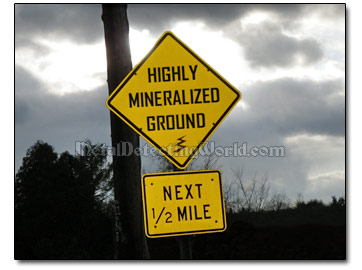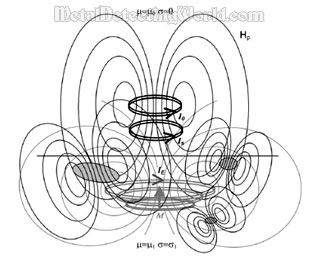Metal Detector's Depth Penetration, page 1
How To Avoid Reduction of Detector's Depth Range Under Search Real Conditions

DEPTH PENETRATION is a maximum detection depth achieved by a metal detector (detector de metal) operated under particular ground-mineral conditions and with a certain search coil. In other words, the metal detector's Depth Penetration is a detector's capability to transmit its electromagnetic field through the ground matrix and respond to detected targets; with other negative factors being absent. In simple words, the Depth Penetration is the detector's DEPTH POTENTIAL affected by mineralization. The Depth Potential can be determined ONLY through empirical observation during an Air Test (Bench Test).
The detector's Depth Penetration not only varies from one area to another according to the ground mineral content, but also depends on sizes and types of the metal detector's search coils used. Anything else, such as improper search programs, wrongly adjusted program settings and modes, inadequate detecting technique, high levels of iron content in the ground, etc., can only negatively affect your machine's DETECTING RANGE (also OPERATING DEPTH RANGE). Your goal is to bring your machine's Detecting Range as close to the detector's Depth Penetration as possible. The latter can equal the Depth Potential if the search ground is free of minerals and iron junk.
This is why, before you go metal detecting under real search conditions, first, you should determine your detector's Depth Potential for sought coins (or other desirable targets) through Air Testing with various search coils, and, secondly, determine the detector's Depth Penetration on particular search ground through a "Depth Penetration Test" (an article on this test will be posted soon). Under the close-to-IDEAL metal detecting conditions and with your OPTIMAL program settings, your detector's actual DETECTING RANGE for targets in focus would be almost equal to the test results. However, in general, the search conditions are far from ideal, not to mention the program settings that are often discordant to some degree with them.
Knowing the following negative factors that can reduce both the Depth Penetration and the Detecting Range of your metal detector will help you avoid passing up desirable targets at hunt sites:
1) Effects of ground minerals present the most common obstacle to maximum transmitter power, and, therefore, reduce depth penetration as well as the accuracy of the Target Audio and Visual ID. High levels of ground mineral content impose a big problem on both the Automatic Ground Balance (Auto Tune) and Manual Ground Balance metal detectors, the latter being affected the most.

Millions of oxidized-iron particles in soil create a "cloud" that may mask the weak electromagnetic fields induced off the deep and small targets.
This natural negative effect may be compounded by improper adjustments made to your metal detector's key controls (settings) such as Ground Balance and Sensitivity (see details below) as well as Discrimination (see details in my article "Less Discrimination Lets You Find More").
Even if just one of these controls is set up wrong, the weak electromagnetic fields of small and deep targets are so overwhelmed by the ground noise - the "cloud", that even the most advanced filtering is not able to "pull them out" of the "cloud".
A picture to the right shows an example: a search coil (two identical loops above a ground line) is positioned over the ground that is free of any metal targets, and the search coil's transmit loop emits an electromagnetic field which induces electromagnetic fields off both the ground itself and three highly concentrated mineral deposits; all this ground mineral "noise" being picked up by the search coil's receive winding (source: "Soil Electromagnetic Properties and Metal Detector Performance" by G. Cross, Terrascan Geophysics).
2) Improperly Adjusted Ground Balance (if using a metal detector with manual GB)
If the objective of manual ground balancing - to enable a detector to compensate the ground mineral content, is not met, the detector's maximum Detecting Range will be compromised as well as the detector's ability to sense small targets. The detector's Visual Target ID circuit would have hard time identifying good targets through the background noise that the ground is creating. If you use high levels of Discrimination, the detector's distorted responses to deep and small targets will be muted.
If you metal detect on the high-mineralized ground and substantial changes in mineral intensity occur, you must frequently readjust the Ground Balance. To eliminate audio responses to hot rocks, you need to adjust the ground balance with a positive offset: when you lower the search coil to the ground, you hear a slight increase in audio threshold. Some advanced metal detectors have the mineralization index value numerically or graphically (mineralization strength) displayed in order to help a user to make prompt adjustments.
If your metal detector does not have such an indicator, you can determine whether or not you need to readjust the Ground Balance by switching to All Metal mode and listening for "nulling" (blanking) of Threshold (constant and barely audible humming). A momentary loss of Threshold will be a cue for you to readjust the Ground Balance. This procedure can not be done with a metal detector that is operated in a Silent Search Discriminate mode because of the absence of the Threshold. This is why the up-to-date 'Silent Search' metal detectors also offer sufficient indication of the ground mineral content.
Stay away from cheap metal detectors that may not have the Ground Balance control. They give a huge disadvantage because they are factory preset to an average ground mineral content. When an area with more intense nonconductive soil is entered with the 'preset GB' metal detector, the detector's Depth Penetration is greatly shortened.
Advanced (expensive) motion detectors with automatic ground compensating circuits cope well with adverse ground conditions because they incorporate a TRACKING system - self-adjusting Ground Balance, which monitors any changes in the ground mineralization and rebalances itself without user's involvement. The older 'Automatic GB' detectors have an adjustable speed of auto retuning (for example, 'S.A.T. Speed' on the White's XLT metal detectors) to optimize pinpointing of the small and deep targets.
3) Using too much Sensitivity intensifies not only the ground mineral interferences but also additional signals from nearby rejected targets - all mixing with the target signal, and the target signal strength gets degraded. If too much Sensitivity is implemented, the detector's circuitry is not able to separate the target's response from responses to other targets and, moreover, to the now amplified ground mineral noise. As a result, the detector's Detecting Range is greatly impaired: the detector's circuitry can not recognize a faint signal from a deep coin among the blend of high Sensitivity circuit noise and ground mineral effect.
You may want to read more about Sensitivity here - "Quieter Operation of A Metal Detector vs. Detecting More Deep Coins" (this article is included in the "Search Programs for Minelab FBS Metal Detectors" section), and on this page How To Search Around Cellar Holes Successfully, page 1.
You can regain the detector's decent Detecting Range by reducing Sensitivity to a level of the detector's stable performance. However, if the ground mineralization is very high, the stability level of Sensitivity may be too low which is not good either. Under such circumstances, your last resort is to replace the current search coil with a smaller one (see details on next page).